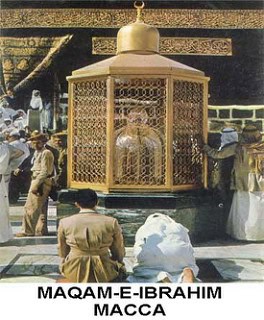Even after 40 centuries, the message and the character of Prophet Ibrahim (peace be upon him) remains exemplary for millions of people. A proponent of monotheism, he declared the Oneness of Almighty God at a time when the whole world was submerged into darkness of polytheism. In this backdrop, he heralded his determination to turn his face to the Almighty God, the One Who is the Creator of the universe.
Born in Babylon (modern Iraq) some 2000 BC, Ibrahim traveled through Syria, Egypt, Hijaz and Palestine, where he died and is buried at a place which is known after his name as Al-Khaleel. He made the entire Middle East areas as his area of operation for his mission, and assigned his nephew Lot (AS) to Sodom; his son Isaac (AS) to Palestine and planted his elder son Ismail (AS) at Hijaz. He is ancestor of most of the Prophets referred to in Old Testament, New Testament and the Holy Qur’an.
THE GREAT ASSEMBLY OF HAJ:
Haj was started by Prophet Ibrahim (AS). It is the perfect replica of the incidents and occasions of the life of Prophet Ibrahim (AS) and his family. Here we mention the main rites of Haj and their relationship with this noble family.
I. CONSTRUCTION OF HOLY KABA:
Almighty Allah bestowed great favor on Prophet Ibrahim (AS) and Ismail (AS) to build the Holy Kaaba at Makkah Mukarramah, which is the focal point of the true faith in the world. Muslims turn their faces towards it in prayer, five times a day from every corner of the earth. Even their dead are buried facing the Holy Kaaba.
II. PERFORMING TAWAAF:
Later Almighty Allah told him to call the people to perform Haj and Tawaf.
III. SA’I OF SAFA AND MARWA:
Every pilgrim is obliged to run between the two hillocks. Where Ismail (AS) mother Hajara ran madly between the two nearby hillocks of Safa and Marwah looking for water gor her son. She ran seven times. The hills and hillocks echoed with her cries. This was a great ordeal indeed.
IV. Zamzam:
This is the water, which gushed out as a gift to infant Ismail. Pilgrims drink it and take it with them as holy water to the four corners of the world.
V. RAMI JAMRAAT:
When Prophet Ibrahim (AS) was taking his son, Ismail (AS) for a sacrifice in Mina the Iblees tried the seduce the family three times and they threw dust and pebbles upon him. The pilgrims follow the same practice and throw pebbles upon Iblees seven times each in three days of Haj.
VI. ANIMAL SACRIFICE:
This is in commemoration of Prophet Ibrahim’s (AS) decision to sacrifice his son Ismail and Allah’s Mercy upon him to ransom it by a sheep. The pilgrims in Mina and other Muslims celebrate the Great Win by sacrificing sheep, goat, cow and camels throughout the world. About two million animals in Mina and many millions abroad are slaughtered within three days whose meat is distributed to the poor. This is the largest free food distribution program of the world on the ‘Eid Al Adha’ annually.
VII. MAQAM-I-IBRAHIM:
This is the place of a stone, marked with the foot print of Prophet Ibrahim (AS) where he was standing while raising the walls of Holy Kaaba. Every pilgrim offers prayer at this blessed place in every Tawaf.
VIII. HIJR ISMAIL:
This place marked with Prophet Ismail’s (AS) name is now a part of the holy Kaaba and pilgrims offer prayer at this place.
The above rites of Haj are directly connected with the noble family of Prophet Ibrahim (AS). Although Prophet Muhammad (peace be upon him) initiated Haj, there is however no Haj rite connected with his life. It is the commemoration of Prophet Ibrahim and his submission to the will of Almighty Allah.
Islam is the religion of Prophet Ibrahim (AS). This is mainstream of Divine guidance including all prophets of Torah and the Bible. Judaism and Christianity are the offshoots of that one thread of divinity.
☆★☆★☆☆★☆★☆★☆★☆★☆

